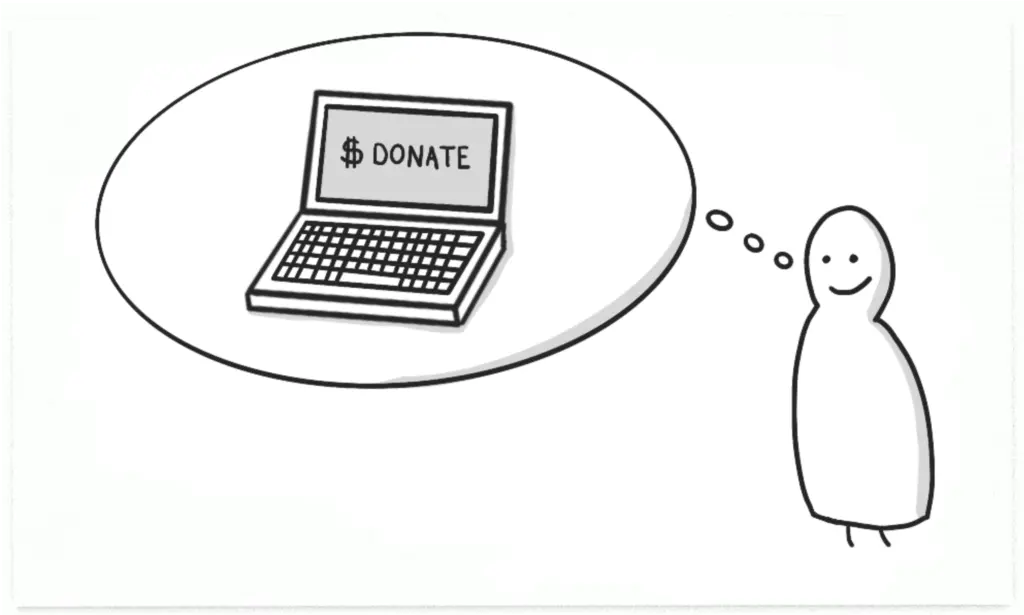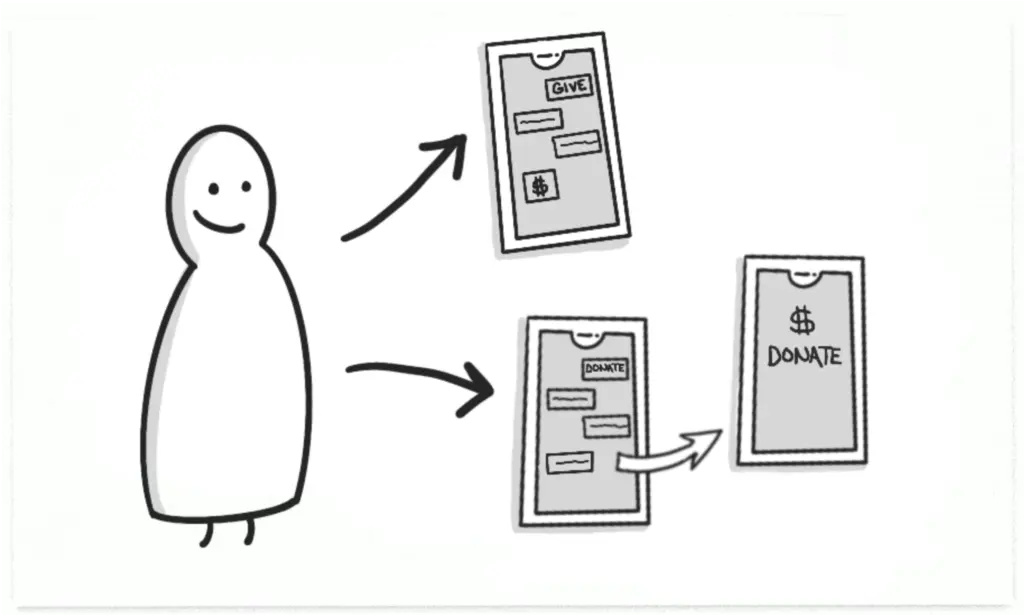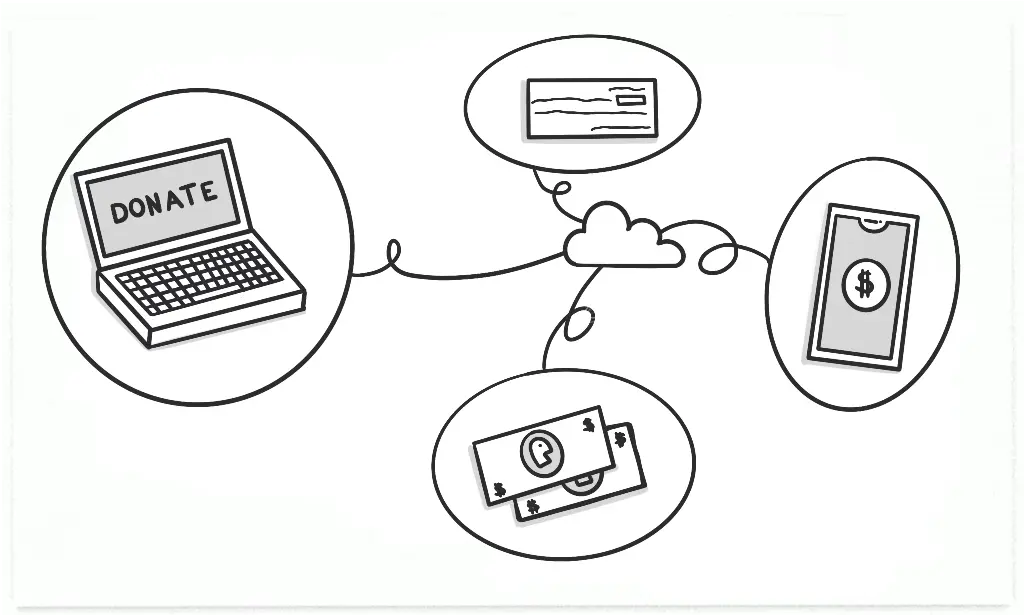
Mobile engagement has exploded in the last ten years and shows no sign of slowing. With the move to mobile, the internet has become ubiquitous. And with ever-present internet comes increased opportunities to reach your audience and help them move from curious passerby to committed donor. Mobile giving more than tripled (9% -> 28%) as a percentage of all online giving between 2014 and 2020! Ministry fundraising needs to keep up or risk being left behind.
Inspirations to give take any number of forms. Your audience may have loved what they heard in your ministry’s radio spot. Maybe your ministry’s presentation at a church or convention moved them. Maybe they were chatting with a friend, and your organization came up in conversation. Whatever the prompting, a mobile donation solution can lead your audience to pick up their phone and become a donor when the mood strikes without the friction of traditional models of giving.
Implementing a mobile donation solution is not as straightforward as it seems. Much of the tech and attitudes around mobile giving continue to lag behind overall mobile adoption. We’ll look at a few options for serving your ministry’s existing donors and making new ones.

A simple option: your website
Practically every mobile device has a web browser built into it. So why not point users to your current website to make donations from their tablet or phone? This might present the simplest option, but it’s not necessarily the best one. What will those users actually see on their mobile device when they load your existing website?
Ten years ago, many websites weren’t designed with mobile in mind. Visiting a website on a mobile device often meant reading tiny text, pinching to zoom, and hunting to find anything. Design trends started shifting from “desktop, and also mobile” to “desktop and mobile equally” with responsive design. As mobile traffic continues to pull away from desktop, attitudes in the design community have evolved further. Today, many websites are designed as “mobile first” and many websites displaying on larger screens look like big versions of the mobile site design!
These design trends increase the likelihood you can point mobile users to your site to allow them to donate. However, at the risk of stating the obvious, your website has to have been designed and built with mobile design in mind. Otherwise, you’re sending your users back ten years to squint and hunt for your “Donate Now” button.

Old school: SMS
Even before mobile phones could access the internet, there was SMS. Decades later, it’s easy to overlook SMS in favor of websites or mobile apps. But SMS can provide a familiar avenue to help funnel users into your donation process. Using SMS to turn users into donors presents both opportunities and challenges.
SMS alone is insecure
SMS is a point-to-point communication tool. Even so, there is no security built into the communication, and text messages should never be used to transmit financial information. As such, SMS alone is insufficient to process donations. You still need to invest in other donation solutions and use SMS as a way to reach your donors.
The two primary ways to use SMS are “text-to-give” and “text-to-donate”. The approach you choose depends on the size of your ministry and whether you wish to focus on the donation or the donor.
“Text-to-give” is simple, but also complicated
If you’ve ever seen or heard a large mobile giving campaign, especially around a natural disaster, you probably already know roughly how “text-to-give” (T2G) works. Those campaigns usually sound something like, “Text ‘GIVE’ to 12345 to donate now!” It prompts you for an amount, and your phone bill reflects that donation. You pay your phone bill, and the phone company sends the donation part of your bill to the non-profit. This is how massive organizations cast an extremely wide net to prompt giving toward a cause. It’s easy, it’s memorable, and it’s effective.
Unfortunately, T2G is not ideal for most ministries. The key benefit of T2G—its simplicity—means the donor uses their mobile provider to give money to the ministry. This practice introduces a mediator between you and your (potential) donor. This buffer makes it very difficult, if not impossible, for continued donor engagement with those who give via T2G.
There are other challenges with the T2G approach. Those convenient 5- or 6-digit numbers (aka “shortcodes,” like “12345” above) are wildly expensive and require significant lead time to set up. In the past, organizations were able to rent these shortcodes through other businesses for a fraction of the cost. However, those shortcode “landlords” seem to have all but disappeared. This leaves ministries with the choice of paying significantly for a shortcode or pursuing a different approach.
“Text-to-donate” is an investment that pays off
The “text-to-donate” (T2D) approach starts off similarly to the T2G approach. With T2D, your users send an SMS keyword (e.g., “DONATE”) to a phone number, usually a local or toll-free 10-digit number.
After that initial message, T2D begins to diverge from T2G. The T2D response includes a URL the user can click to open in a mobile browser to complete their donation.
The donor then fills out the donation page on your site, including their credit card information and any account details with your organization. They submit their donation, and you receive it in near-real time. You can send a followup email or SMS thanking them for their donation, inviting them to further interactions, and so on.
While T2D is slightly more complicated for your donors at first, it’s still preferable for almost all ministries. It costs far less to set up and maintain than T2G. Text-to-donate usually uses a donation page that (almost certainly) already exists on your website. It fosters direct engagement with your donors and ensures you have all of their information. This allows you to not only thank them directly for their gift but to contact them in the future. Direct contact will help encourage them to go from user to donor; ongoing contact will drive them from donor to advocate, bringing new donors of their own.
“Text-to-donate” gives your donors more options for repeated gifts
T2D also gives your donors a smoother path to repeat mobile giving via SMS. Where the initial contribution cannot happen entirely over SMS, follow-up donations can. If your donors’ phone numbers and credit cards are saved with their accounts, you can build a system that allows them to repeat a donation with a couple of SMS messages. For example, they might text “GIVEAGAIN” to your 10-digit phone number. Your system can respond asking them to send an SMS to confirm. Once confirmed, it charges their credit card the same amount as their last gift.
This requires a little more engineering than even the initial T2D interaction where the system receives a keyword and simply returns a URL. Indeed, in some ways this might sound unbelievable or unattainable! But it’s well within the realm of possibility and only requires some investment. The payoff is giving your existing donors one more smooth process to donate on a mobile device when they are inspired.

Shoulders of giants: donation platforms
As with most operational aspects of your ministry, you have the option to outsource mobile donations. There is a growing number of third-party tools that can help process donations and give your users mobile options for donating. The question comes down to what’s most important to you and whether there’s a good match in a provider.
Options can be valuable, but overwhelming
With providers like Tithe.ly or Donorbox, the feature list can seem nearly endless. If you’re looking for a comprehensive system that solves all sorts of problems, you might consider an all-in-one solution like these. But if you’re only looking for a mobile donation piece to drop into your existing setup, these could be a bad match. And they might also require that you use their other tools in order to use their mobile giving tool.
The best way to navigate an overwhelming list of options is to contact the product’s sales team. They’ve often streamlined the evaluation process for ministries like yours to ensure they can provide only what you need. As an added benefit, you get a chance to work with their sales and solution engineering teams to get a good feel for their company.
A focus on integration
The best third-party service providers will have focused on how easily you can integrate their tools into your existing toolkit. They will also have a solution engineering team that can solve almost any new integration problem. They know their mobile donation feature is only a good solution for you if it will integrate into your workflow. Their experience with integrating their tool into many different environments gives them insight into how to best do that for you.
General solutions can be weak solutions
When someone else is providing the solution you’re using, they may not have the same goals or requirements as you. A general tool meant to serve tens of thousands of users might not provide exactly the functionality you need. When you’re looking at donation platforms, you might end up running into some of these weaknesses.
Maybe accepting eCheck donations is important to your ministry, but a platform’s mobile donation solution doesn’t support them. Maybe the mobile app they supply isn’t customizable and gives your users a generic experience. If the app is unreliable for you but functional for other customers, the vendor may not be invested in fixing the problem. When it’s someone else’s tool you’re using, you’re at their mercy to develop and maintain it.
Donation platforms often offer other features beyond mobile donations: a website, event management, an SMS sending platform, and more. These extra features may not be “best in class”; they can leave you frustrated, yet more “locked in” with a vendor’s bundle of tools. You should evaluate the mobile offering outside of any other features to get an accurate sense of its value to your ministry.
The question of whether to offer your users options for donating via mobile is settled. With an ever-increasing percentage of donations coming from mobile, your ministry is missing an opportunity without a mobile donation strategy. If you’re not sure how to develop your mobile donation strategy, or if you’re not sure if yours is effective, don’t panic. It’s never too late to get started: contact Agathon below and we’d love to discuss it with you!